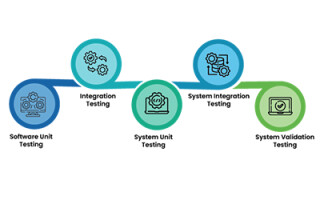Embedded Testing Vs Software Testing – Key Differences
April 15, 2024
Blog

In today's technologically progressive world, it is mandatory for companies to test their software. Regular testing ensures that the software works well and keeps the whole system running smoothly. This is true not only for regular software but also for embedded systems and hardware. Proper testing is needed to make sure both the software and the hardware are highly secure. Let's understand the basics about embedded testing and its key difference with software testing.
Why Embedded Testing?
Following is the importance of embedded testing to deliver reliable and high-quality embedded systems.
- Identify and resolve potential issues to ensure the system’s security, reliability and performance
- Validate compliance with industry standards and regulations
- Boost performance by identifying potential problems such as memory leaks or excessive battery consumption
- Perform complex tasks to complete within the required period and avoid delays in system performance
- Ensure smooth interaction and functionality between the software and the hardware
Software Testing Vs Embedded Testing
Following are some major differences between embedded testing and software testing:
|
Embedded Testing: |
Software Testing: |
|
Both hardware and software are tested |
Web & mobile app get tested |
|
Tested with black box or white box testing |
Tested purely with manual black box testing |
|
Carried out to test the behavior of the hardware, not related to any database |
Database can be tested with software testing techniques |
|
Less costly and time consuming as testing process is manual |
Costly and time taking process |
|
Generally carried out on embedded systems/hardware |
Performed on mobile, client-server and web applications |
|
Limited scope for automation |
Testing can be done with both manual and automation process |
Embedded Testing Challenges
The differences outlined above insights into the challenges can be faced in the process of conducting embedded software testing. Here are some significant consequences that may encounter during such testing:
Scope of automation
Automating tasks in embedded testing projects proves challenging for developers and test engineers because embedded software testing solutions rely on hardware and its associated interfaces. Therefore, there is a necessity to develop a test rig capable of automating processes for both software and hardware.
Dependence on hardware
Limited access to hardware presents a major challenge in embedded software testing. Here, emulators and simulators might not accurately reflect the actual device's behavior, potentially misrepresenting how the system operates and the applications are used.

Recreate defects
Recreating defects in embedded systems is challenging, requiring embedded testers to precisely observe each error occurrence, exceeding the attention usually provided in conventional situations. This involves gathering sufficient data to effectively identify and address the root cause of the error.
Regular software updates
Regular updates, including security fixes, RTOS updates, kernel upgrades, and other modifications, need to be consistently applied to an embedded system. These changes can directly result in testing processes, demanding increased attention throughout development, production, and deployment stages.
Open-source software
Open-source components for testing embedded applications are widely available. However, they often lack thorough testing, resulting in various test combinations and outcomes.
Different Ways of Performing Embedded Testing
To test embedded systems, the system needs to go through five industry-wide levels of testing.
Software unit testing
In the context of software development, a unit module can present itself in the form of a function, procedure, or class. This process entails isolating a specific segment of code and ensuring its accuracy through verification. Oversight of unit testing typically falls on the developer, followed by a subsequent peer-review phase. Formulating test cases based on module specifications ensures a thorough validation of the code's functionality.
Integration testing
Software integration testing and software/hardware integration testing are two major integration testing for embedded systems. It is about how software talks to the hardware and checks how the software works with integrated devices. Testing embedded applications is much like testing regular software which always takes place in the real world. Many testers emphasize the importance of embedded testing services because simulated environments fall short in conducting thorough testing.

System unit testing
Within the test module, there's a comprehensive framework housing detailed information about software codes and the real-time operating system which includes mechanisms, interruptions, communication and more. Afterward, the control protocol point aids in facilitating communication, ensuring its passage through the RTOS message queues. Following this step, the developer or the system integration team evaluates system resources to confirm their ability to sustain the execution of the embedded system. This process often involves the application of gray box testing
System integration testing
The testing module initiates from a collection of components, encompassing subsystem components, all consolidated within a single node. Combining network communication protocols and RTOS, the Control and Observation Points consist of network messages and RTOS events. In this scenario, components such as the Virtual Tester also play a role similar to a node
System validation testing
Either a complete subsystem or the entire embedded system serves as the module requiring testing. The ultimate objective of this final test is to fulfill the functional criteria outlined by the external entity. It is important to highlight that the external entity may involve either a human or a device within a telecommunications network, or possibly both.
At this stage, it becomes clear that embedded software testing poses greater challenges compared to software testing. Due to the heavy reliance on the hardware environment, which is developed concurrently with the program, reliable software testing often necessitates its inclusion. Testing software without custom tools can be difficult, thus making late-phase testing highly appealing.





